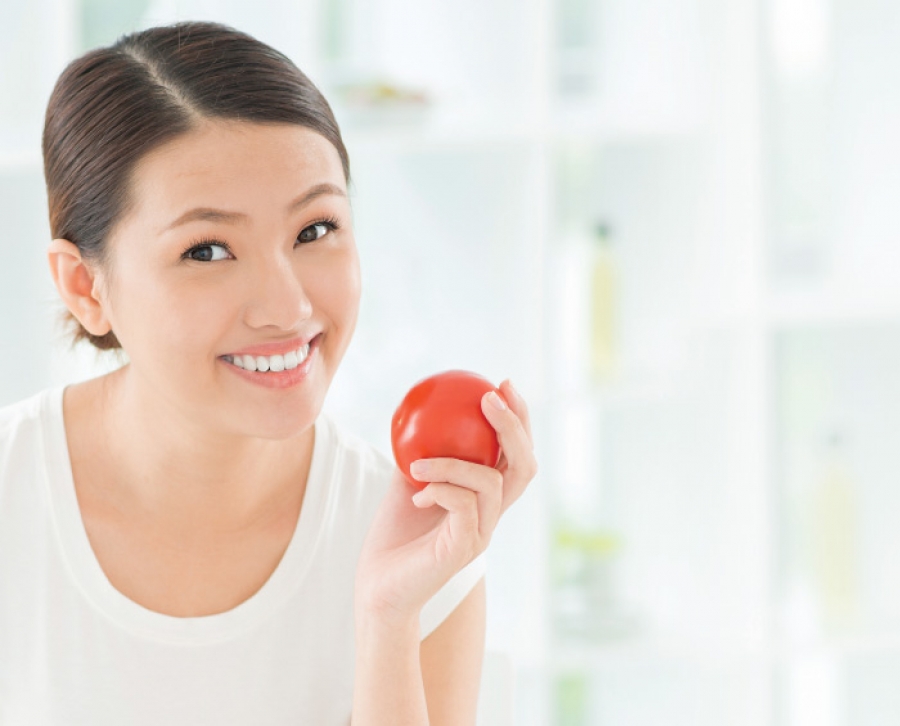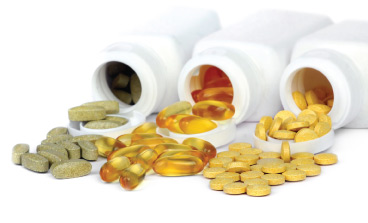 To help your clients get the most benefit from this information, share it with them and encourage them to use their own judgment and/or a discussion with their doctor before making any changes to their diet. Each person presents a unique set of circumstances and it is important to remember that common foods can sometimes be contraindicated with certain medications and health conditions. The key is to encourage them to take their health into their own hands and to remind them that moderation is always the best approach.
To help your clients get the most benefit from this information, share it with them and encourage them to use their own judgment and/or a discussion with their doctor before making any changes to their diet. Each person presents a unique set of circumstances and it is important to remember that common foods can sometimes be contraindicated with certain medications and health conditions. The key is to encourage them to take their health into their own hands and to remind them that moderation is always the best approach.
Foods That Improve the Skin’s Natural Sun Protection Factor
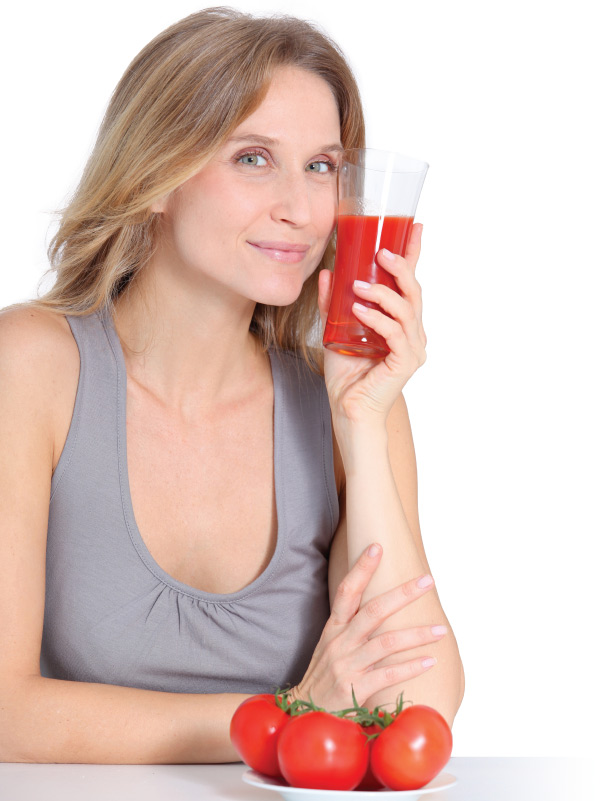 Tomatoes
Tomatoes
A 2008 study found that tomatoes have the remarkable ability to help the skin protect itself against ultraviolet (UV) induced damage. This study asked one-half of participants to consume five tablespoons of standard tomato paste in two tablespoons of olive oil per day, while the control group of participants consumed just the olive oil. The skin of participants in both groups was exposed to UV light before the study began and again after 12 weeks. The skin of participants who had consumed the tomato paste was significantly more able to protect itself against the UV exposure than those who consumed only olive oil.5
The hero in this study is lycopene, a phytochemical found in tomatoes. This super nutrient is found in many red colored foods, but is at its highest concentration in cooked tomatoes. The best part about this study is that the amount of tomato paste consumed is not excessive; it is approximately equivalent to one serving. While study participants did consume this amount each day, this was for only 12 weeks. It is reasonable to imagine that a longer period of slightly less frequent consumption might yield results as well.
Suggest that your clients take advantage of this natural protection by indulging several times a week in a homemade tomato sauce, perhaps over spaghetti squash with a green vegetable on the side.5
Vitamins E and C
Since humans cannot synthesize vitamin C naturally, it is important to ensure that we are consuming enough through the foods we eat. While the days of scurvy are long gone, many people suffer from low levels of chronic vitamin deficiency. One small study indicates there may be UV protecting benefits hidden in combining vitamin E and vitamin C. In this study, participants were asked to begin consuming two grams of vitamin C and 1,000 IU of vitamin E per day. After just eight days, their skin was exposed to UV light and showed a modest decrease in sunburn. Additionally, a study of 40 participants over 50 days showed that consumption of higher doses of these vitamins together can, in some cases, provide a sun protection factor of 2. When comparing this information to an average sunscreen with a sun protection factor anywhere between 15 and 50, this may not seem like much; however, when we remember this is a natural increase based solely on consuming vitamins to nourish our body, the results really are remarkable.6
According to these studies, the two vitamins must be taken together in order to see the sun protection benefit. When taken separately, the results were not as promising. Share these findings with your client and if they are interested in adding this boost to their routine, instruct them to speak with their doctor to determine the safest dose for their unique physiology.1
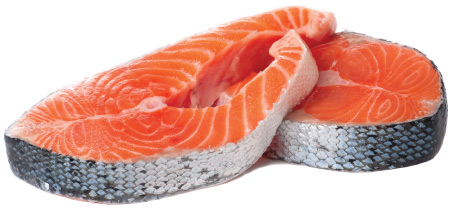 Shrimp and Salmon
Shrimp and Salmon
We have all heard that Flamingos are pink because they eat shrimp, but why are shrimp pink? Both shrimp and salmon have a pink hue because they eat an algae species called Haematococcus pluvialis, which are rich in a nutrient called astaxanthin.2 This powerful carotenoid has been shown to be effective in reducing UV damage incurred by hairless lab mice. The study, performed in France, states that, “…The oxo-carotenoid astaxanthin has a superior preventive effect towards photo-oxidative changes in cell culture.” The nutrient protects skin cells from harmful changes caused by sun exposure.1
Instruct your client to take advantage of this nutrient by occasionally incorporating shrimp or salmon into their diet. Because seafood and shellfish can be sources of mercury, the EPA recommends different frequencies of consumption for different groups of people (pregnant or nursing women, young children), so be sure your clients research which levels are right for them before increasing consumption.3 An alternative to consuming seafood is to take astaxanthin internally in the form of an oral tablet, which is available at many health food stores.
 Pomegranate
Pomegranate
Renowned since ancient times, the unique composition and vibrant color of the pomegranate practically scream superfood. One preliminary study claims that topical application of pomegranate extract can increase the effectiveness of topical sunscreens by up to 20 percent; when combined with consumption of pomegranate extract, the increase in effectiveness jumps to 25 percent. The study states that “Pomegranates contain an important polyphenol called ellagic acid, which is a powerful free radical scavenger. It is extremely effective in increasing the body’s own built-in antioxidant glutathione, which, in turn, helps protect the DNA in cells from free radical damage. Glutathione is also essential in helping the body recycle hormones such as estrogen, which aids in protecting skin cells.”4
This complex fruit is in a league of its own with regard to mitigating the effects of the sun as it may do more than just protect skin from incurring damage. Studies show it possesses the potential to multi-task as a skin brightener, making it useful both pre- and post-sun. When applied topically to the backs of guinea pigs, a 90 percent concentration of ellagic acid harvested from the rind of the pomegranate yielded promising skin brightening results. Additionally, this ellagic acid concentration was shown to produce tyrosinase inhibiting effects in mushrooms in one in vitro experiment.8
Help your client take advantage of the protective and reparative benefits of pomegranate by recommending that they incorporate several servings per week into their rotation of fruits. Many people are overwhelmed by the preparation of this perplexing fruit and so they avoid it, however, there are many different methods available and serving pomegranate can be very simple.
The Other Side of The Spectrum: Photosensitizing Foods
While we are all aware of the more traditional sun sensitizing ingredients like retinols, there are less sinister seeming culprits that can cause damage under the radar.
St. John’s wort
St. John’s wort is a supplement commonly recommended for helping to treat depression; however, this natural substance contains hypericin which has been shown to increase photosensitivity. If your client is taking St. John’s wort, be sure to discuss this risk with them and instruct them on increased measures to protect their skin from the damaging rays of the sun.6
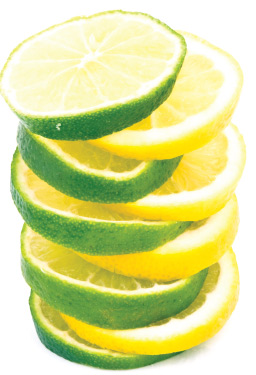 Lime, Parsley, Carrots, Parsnip, Celery, Fig Leaves, Lemon, Mustard and Chrysanthemums
Lime, Parsley, Carrots, Parsnip, Celery, Fig Leaves, Lemon, Mustard and Chrysanthemums
Just perform a simple Internet search for “lime juice and sun” and your screen will be inundated with reports of unsuspecting people who used lime juice to cook or make cocktails and then suffered symptoms ranging from discoloration to rashes to burns from the unlikely combination. The condition is called phytophotodermatitis and it can occur after exposure to several different common foods followed by sunlight. The reaction usually appears around 24 hours after exposure and can last for days to weeks.7
Chances are high, especially in the summer months, that you could encounter a client with this difficult to identify condition. If you do, here is a course of treatment recommended by the University of Minnesota Medical Center:
“On the first day, apply ice packs to relieve severe pain. Over-the-counter first-aid creams and sprays (Solarcaine, for example) contain an anesthetic which also relieves pain. If a dressing was applied, change it once a day. If the bandage sticks, soak it off in warm water. Wash the affected area daily with soap and water and pat it dry with a clean towel. Use hydrocortisone cream to reduce any inflammation. You may use acetaminophen (Tylenol) or ibuprofen (Motrin, Advil) to control pain, unless another medicine was prescribed. [NOTE: If you have chronic liver or kidney disease or ever had a stomach ulcer or GI bleeding, talk with your doctor before using these medicines.] Do not use ibuprofen in children under six months of age. If you know what plant caused your reaction, avoid this plant in the future.”7
It is important to remember that many foods and medications can cause photosensitivity and the occurrence can vary immensely from person to person. Consult a doctor if you feel the condition is outside of your scope of practice, particularly in the event of a serious burn.
A Potent Combination
Mother Nature intelligently provides many methods to enhance the skin’s ability to fight off attackers of all kinds, including damaging UV rays. While the studies mentioned above may not provide any method that could be used as stand-alone sun protection, by exploring all avenues and beginning with a healthy/nourished body, your clients have the best chance at protecting their skin from myriad issues caused by the sun including age spots, sunburn, cancer, and the appearance of aging.
References
1 Camera, E., Mastrofrancesco, A., Fabbri, C., Daubrawa, F., Picardo, M., Sies, H., & Stahl, W. (2008). Astaxanthin, canthaxanthin and beta-carotene differently affect uva-induced oxidative damage and expression of oxidative stress-responsive enzymes. Experimental Dermatology, 18(3), 222-31. Retrieved from http://www.ncbi.nlm.nih.gov/pub-med/18803658
2 Crumley Hill, S. (2013, August 16). Food sources of astaxanthin. Retrieved from http://www.livestrong.com/article/40341-sources-astaxanthin/
3 Environmental Protection Agency. Fish consumption advisories. (2013, November 20). Retrieved from http://www.epa.gov/hg/advisories.htm
4 Murad, H. (2006, June). Pomegranate: Nature’s oldest ultraviolet protection. Retrieved from http://www.skininc.com/treatments/suncare/20656409.html?page=1
5 Newcastle University. Tomatoes found to fight sun damage. (2008, April 28). Retrieved from http://www.ncl.ac.uk/press.office/press.release/item/1209390017
6 NYU Langone Medical Center. Aging skin. (2013). Retrieved from http://www.med.nyu.edu/content?ChunkIID=38389
7 University of Minnesota Medical Center. Plant & sun dermatitis (phytophotodermatitis). (2013). Retrieved from http://www.uofmmedicalcenter.org/healthlibrary/Article/116407EN
8 Yoshimura, M., Watanabe, Y., Kouichi, K., Yamakoshi, J., & Koga, T. (2005). Inhibitory effect of an ellagic acid-rich pomegranate extract on tyrosinase activity and ultraviolet-induced pigment. Bioscience, Biotechnology and Biochemistry, 69(12), 2368-2373. Retrieved from http://www.comilac.com.tr/uploads/pdf/40pomgt.pdf
 Erin Ferrill is a licensed aesthetician and the East Coast Educator for the award winning anti-aging collection, HydroPeptide. As East Coast Educator, she prepares, coordinates and conducts on-site and web-based education on topics relating to peptides, stem cells, and product knowledge with an emphasis on helping spas improve retailing for the benefit of the business, the aesthetician and, most importantly, the client. Additionally, Ferrill is honored to serve as a Look Good Feel Better program volunteer for the American Cancer Society, helping cancer patients deal with the appearance related side effects of treatment. This email address is being protected from spambots. You need JavaScript enabled to view it.
Erin Ferrill is a licensed aesthetician and the East Coast Educator for the award winning anti-aging collection, HydroPeptide. As East Coast Educator, she prepares, coordinates and conducts on-site and web-based education on topics relating to peptides, stem cells, and product knowledge with an emphasis on helping spas improve retailing for the benefit of the business, the aesthetician and, most importantly, the client. Additionally, Ferrill is honored to serve as a Look Good Feel Better program volunteer for the American Cancer Society, helping cancer patients deal with the appearance related side effects of treatment. This email address is being protected from spambots. You need JavaScript enabled to view it.
